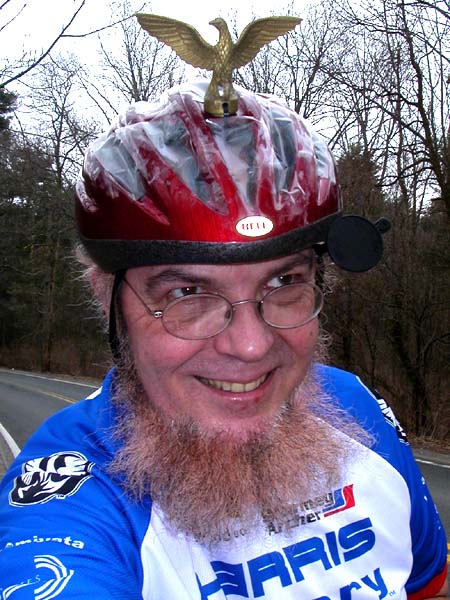My twin brother Willie (who runs teams of engineers that design highly-sophisticated silicon chips) used to say that there were three kinds of computer "ware": hardware, software, and wetware. Hardware and software (and their distant cousin, firmware) you already know about, if you're using the Web to read this. Wetware is, of course, the user of the computer, and ultimately where the rubber meets the road, so to speak.
It seems to me that when one thinks about bicycle-commuting systems, the same three levels impose themselves. Let's consider them in reverse order:
There's the "wetware" crowd, the people who get out there and "just do it". Sometimes referred to as "vehicular cyclists", they insist that all that they need is the road and the rules for it, which exist everywhere. They tend to be skeptical of structured solutions. The most radical among them can be rather vocal in their beliefs that structure is bad, and will give the powers that be the ability to segregate cyclists to a second-class status. (I count myself in this crowd, although to be sure not one of the radical ones.)
Then there's the "software" crowd, the ones who think that to be safe, cyclists need the protection of bike lanes and striping -- clear demarcations that differentiate cyclist territory from motorist domain. Sometimes referred to as "infrastructuralists", they don't commute as much as vehicular cyclists, simply because bicycling infrastructure isn't so widespread as it could be.

Those among this group who do commute regularly therefore are geographically distinct -- they tend to be located out West, in Oregon, Colorado, and parts of California and Washington. Sort of like rare birds with a distinct habitat.
Finally, there's the "hardware" group -- those who think that to be safe, bicyclists need their own separate and independent bikeways. These can be bike paths (typically engineered for about 8 mph, and leading to recreational destinations, not so great for commuting, really) or fully separate bike lanes (preferably with curbs to physically separate them from cars). The Achilles' heel of these approaches is usually the place where they have to come back to the "standard" roadway system. Rejoining the regular transportation system is the most critical aspect of any separated system, and often times it is under-engineered (the "engineering" consisting of a wheelchair ramp at the curb.)
I have a 3/8 mile stretch of bike path paralleling a busy road that I use on my daily commute, and I have learned that rejoining the traffic from that path is by far the most treacherous part of my daily ride.
Recently, a couple of designers have gone quite a bit further and proposed systems that totally separate bikes from the quotidian automobile infrastructure. (Maybe I should categorize these as "super-hardware" people.) Personally, I find them amusingly naïve and impractical. Naïve, because these people are convinced that public financing can be found for these schemes when it's hard enough to find money and will to do simple striping. Impractical, because I don't see where these structures provide the motiviation to ride. If one is motivated, he or she tends toward the "wetware", and all these other things just become (in their absence) excuses not to ride.
I'm not trying to be mean here, it's just my belief that since the advent of the first commercial "safety bicycle", the bike has evolved into a pretty efficient system which works pretty well quite on its own, thank you very much. When I see a new idea to improve the system, I'll be the first to doff my helmet. but it's not so easy to get excited about ideas that just tinker around the edges.
Anyway, let's take a look at a couple of these visionary pretexts for not riding.
 Vel0-City
Vel0-City is a system of elevated enclosed tubes proposed for Toronto. To its credit, it seems to have the macro-planning thought out in that it appears to be integrated into the mass transit system as a whole. To be fair to the envisioners of this project, I think that protection from the elements in the winter in Toronto is a winner of an idea, but I wonder if the good taxpayers of Toronto will support yet another mode of mass transit, in addition to its existing bus, tram, and metro lines. Like any of those other mass transitways, I suspect, graffiti would pose an ongoing problem.
Remarkably, Velo-City promises a perpetual tailwind, with one-way tubes somehow creating a "dynamic air circulation loop." I could use some of that, but I wonder about the physics!
 The Shweeb
The Shweeb (no, I don't know where the name comes from -- it seems vaguely German in its tendency to clear the throat) is a pedal powered monorail that exists as an amusement park ride in Roterua, New Zealand. Two pedal-powered capsules swing around a 200M monorail racetrack. Frankly, this looks like quite a bit of fun. The fun rumor is that someone in the London Development Agency has latched on to this idea as a means of mass transit in London. (Don't you just love the "science-fiction pulp magazine cover" look of the rendering at right?) I think this idea works much better as an amusement park race than as a mass-transit system. I'd hate to get stuck behind the little old lady who's doing some urban sight-seeing when I'm in a hurry to get to work. And as much maintenance as Velo-City would require in removing graffiti, Shweeb would require in spades. Believe me, you don't want the capsule that's just been given up by the vomiting drunk!

As a postscript, here's a different take on bikes-as-infrastructure:
Hybrid-squared. This system proposes a public bike system (think Vélib) whose bikes have a combination of dynamos and regenerative braking to charge ultracapacitors that then dump their stored energy back into the grid when you return the bike to its station. It's a neat
gedankenexperiment, and envisions a credit system where bike-commuting pays for mass transit use, which is a clever scheme. But I wonder if the net energy would amount to a hill of beans, enough to ever pay back the investment in infrastructure. (Is anybody running the numbers on these flights of fancy?)



















